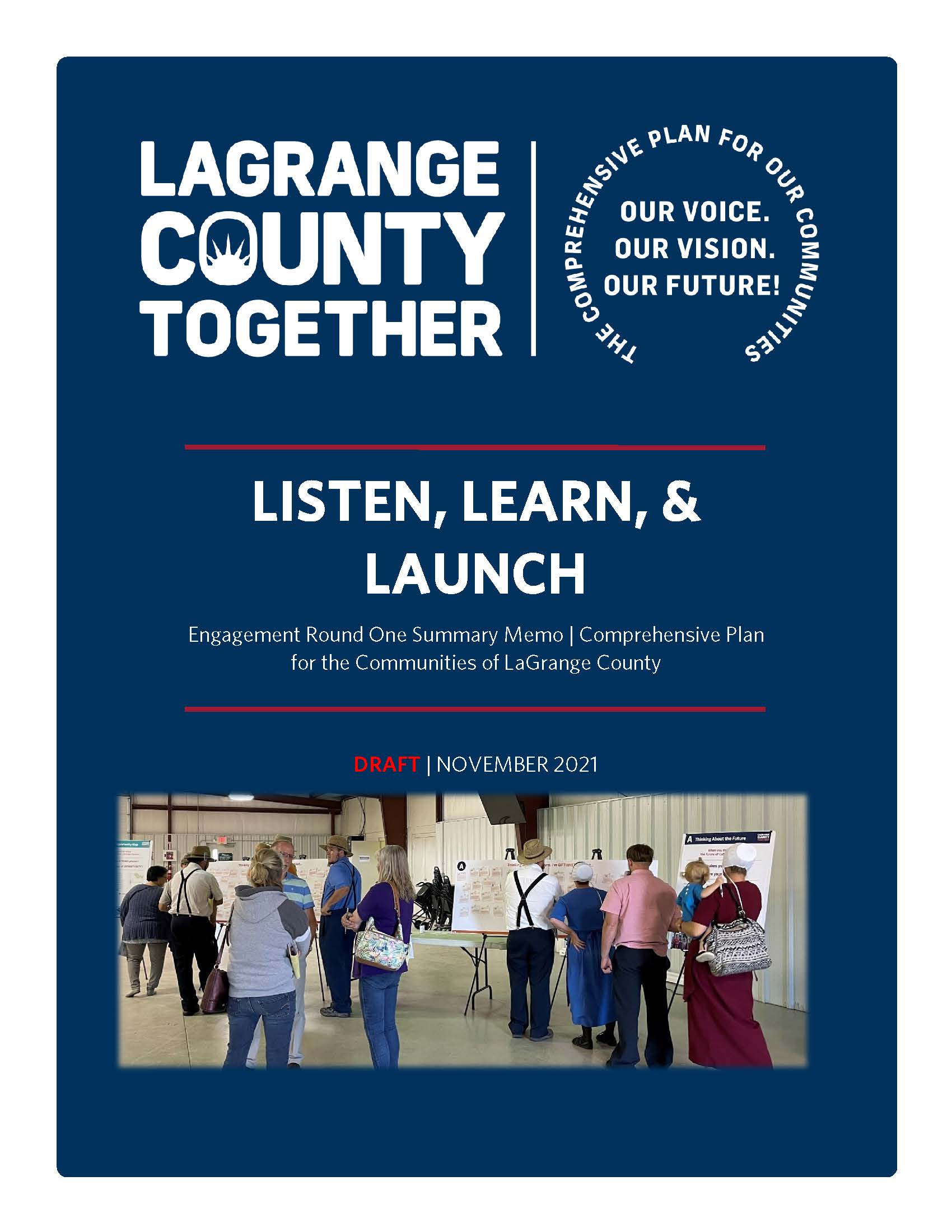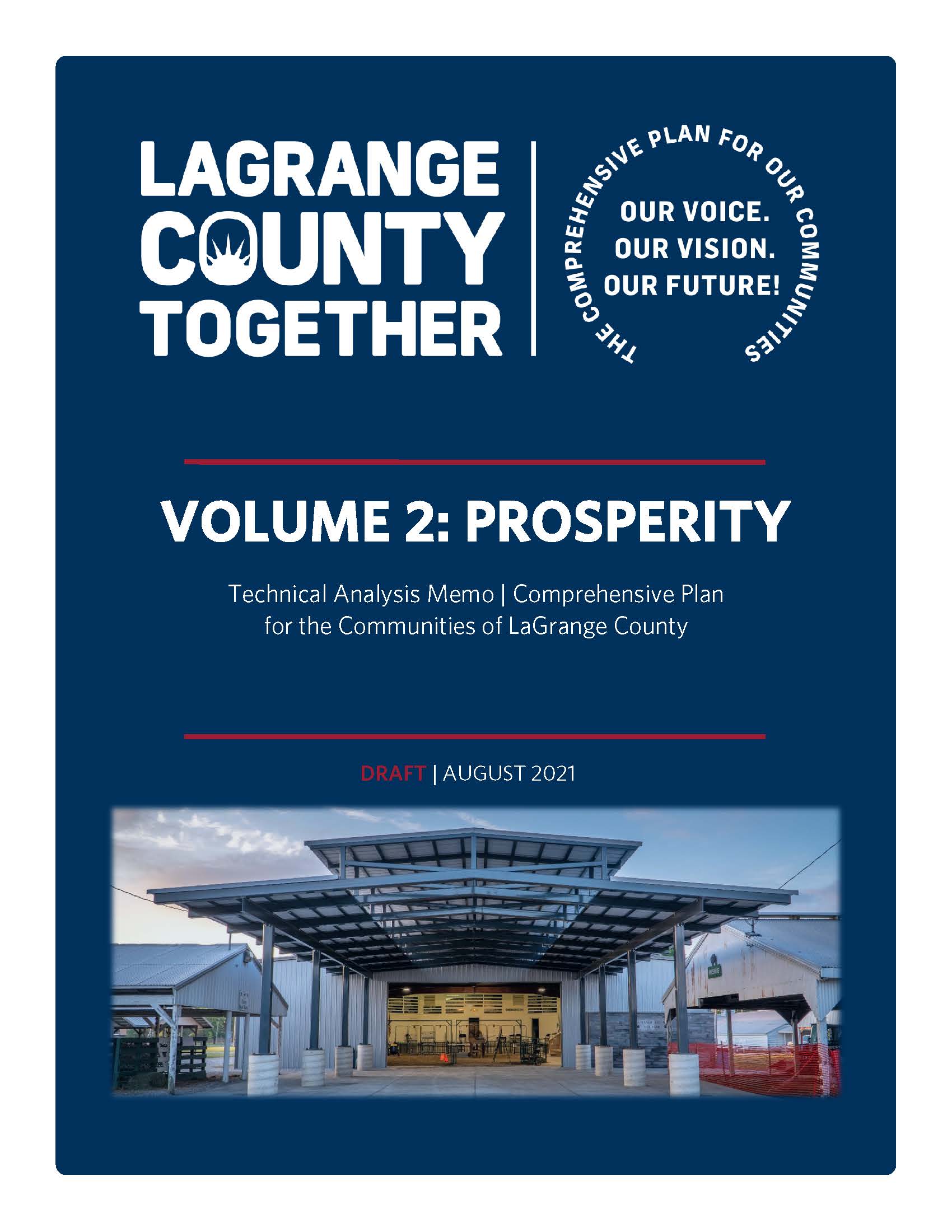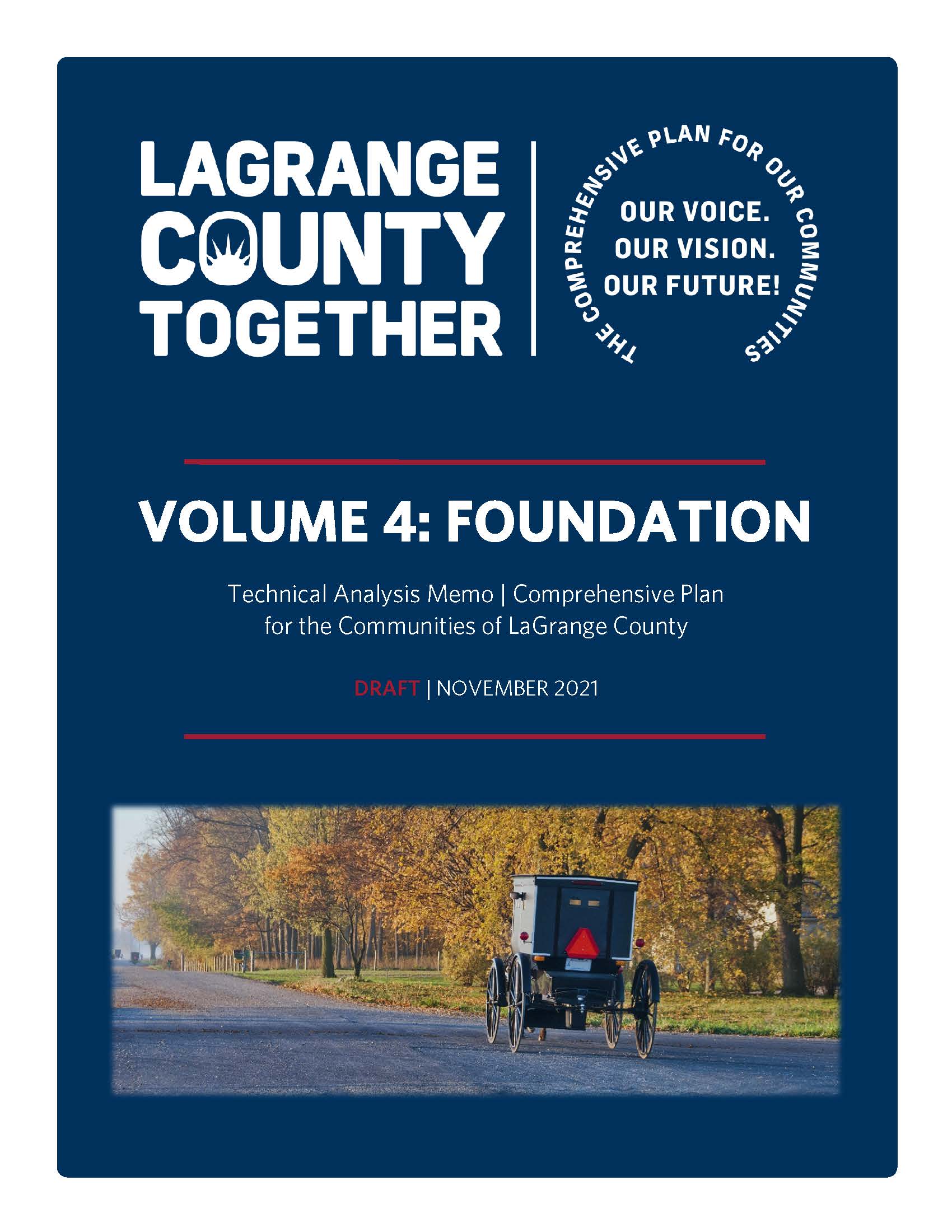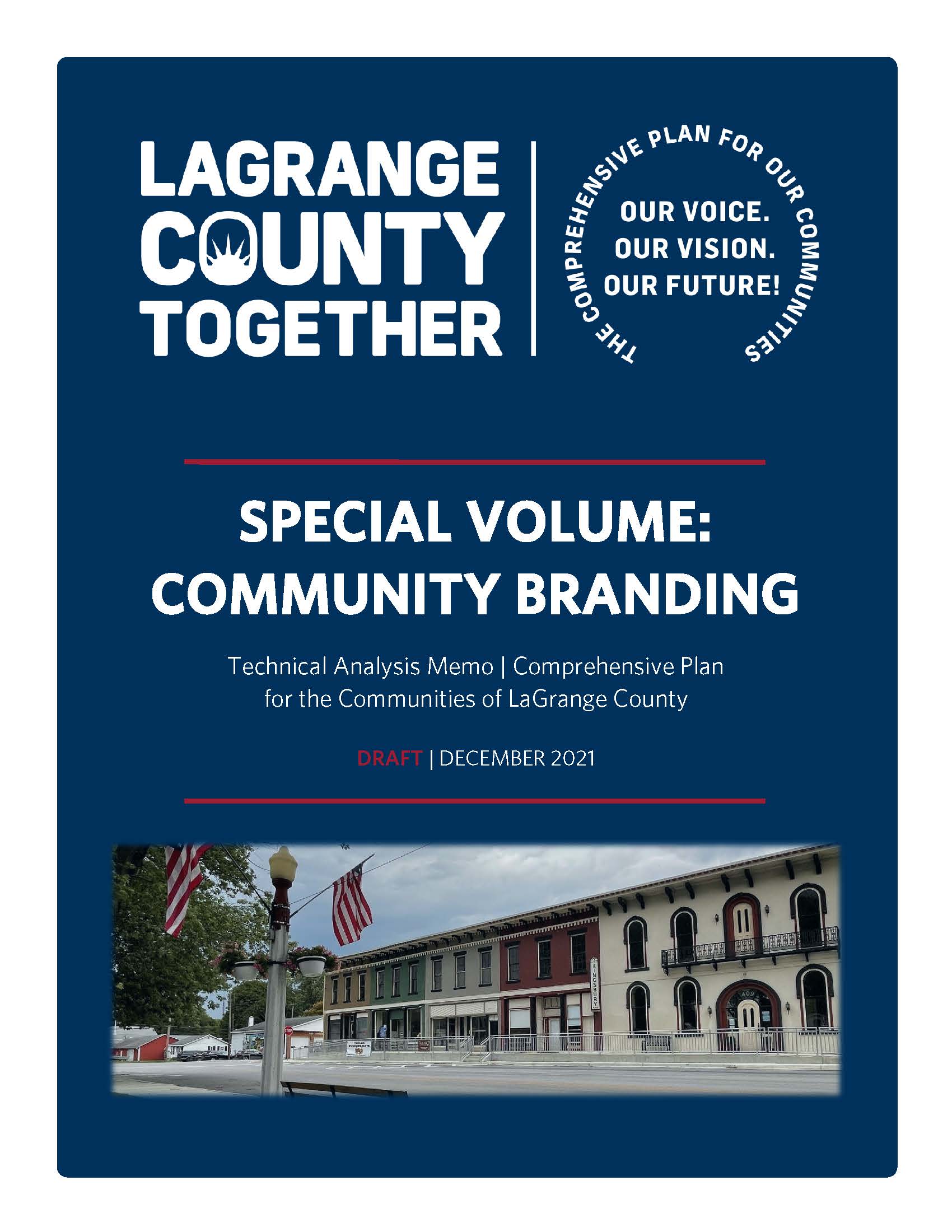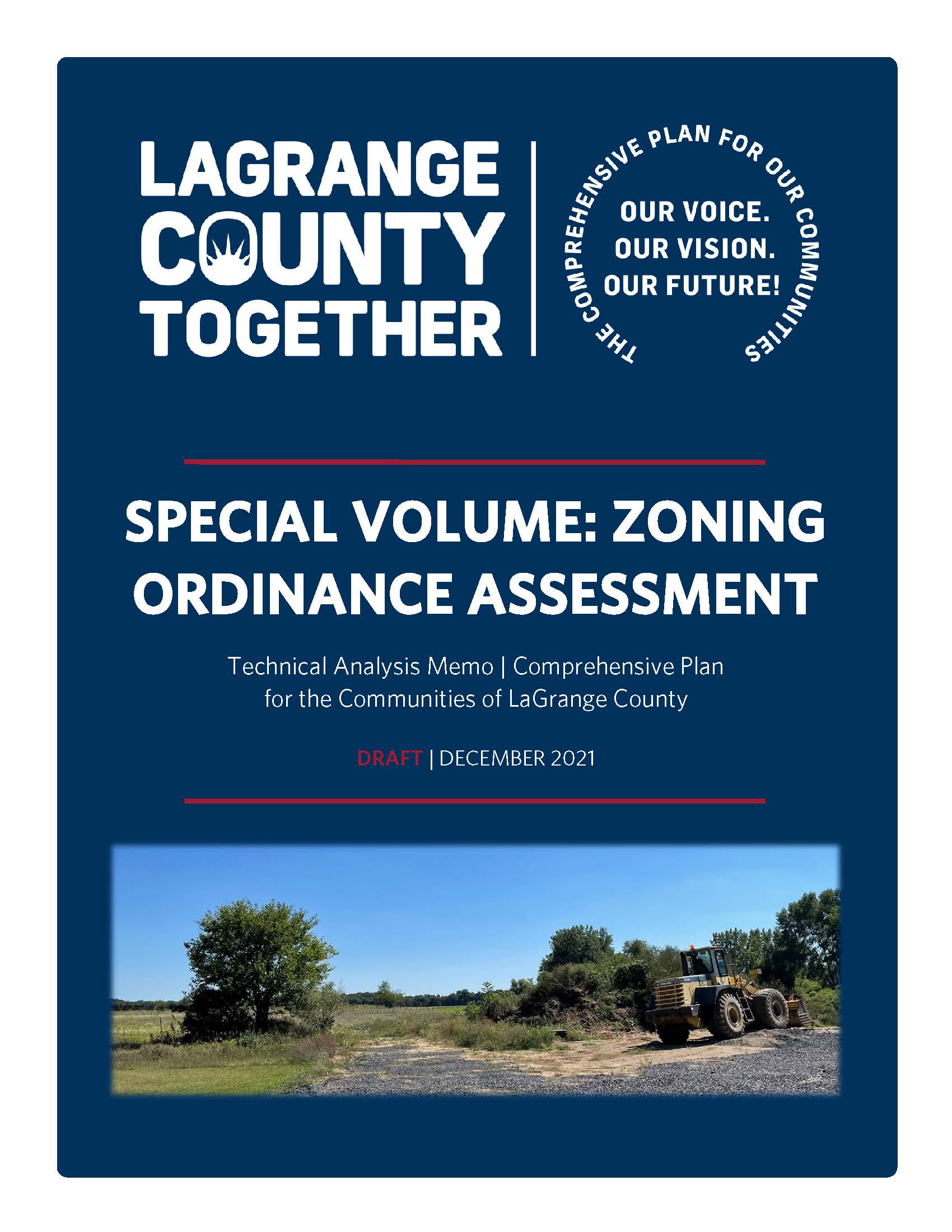Key documents, memos, and presentations created throughout the LaGrange County Together planning process will be posted here for download and review.
Community Engagement Summaries
LaGrange County Together’s community and stakeholder engagement phases are designed to generate open comments on paths to improving the county’s qualities of place, life, and opportunities.
Round Two Engagement Summary
The LaGrange County Together Steering Committee hosted the Summit on the Future on Tuesday, February 22, 2022. Around 100 residents, community leaders, business owners, and elected officials joined the committee at the Fairgrounds Community Building in LaGrange to hear what’s been learned through the process and begin shaping strategies for the future. An additional 225 residents participated in the online summit, following the in-person event, providing input from over 325 total participants in the second round of engagement.
The second round was designed to build on the Listen, Learn, and Launch open houses to begin shaping the structure for the comprehensive plan. The event connected technical analysis conducted by the consultant team with key findings gathered from the community. The discussion was focused on two key question prompts for the Summit: “Where do we grow?” and “How do we grow?”. The responses helped shape the major components of the comprehensive plan including the draft vision statement, goal statements, and specific strategies for enhancing the communities of LaGrange County.
Round One Engagement Summary
The LaGrange County Together Steering Committee hosted the Listen, Learn, and Launch open house events to kick off the first round of engagement for the planning process. These events gathered feedback from more than 250 people through both in-person discussions and online activities. The responses shared by participants provided the Planning Team with a fuller understanding of residents’ thoughts, ideas, and concerns for the County’s future.
These responses identified several major takeaways that will guide the development of the comprehensive plan and next round of public engagement. Major themes included:
- Experiencing new housing growth
- Promoting sustainability and conservation of lakes
- Supporting local entrepreneurship and industry growth
- Addressing challenges to building and permitting
- Expanding broadband throughout the County
- Highlighting unique destinations for tourism
- Maintaining a sense of community
- Improving childcare access and cost
- Revitalizing downtowns through improvements and amenities
- Enhancing roadway safety, quality, and traffic mitigation
Technical Analysis Memos
The Comprehensive Plan is made up of 11 topics that range from land use and transportation to natural resources and education. This research and analysis will help inform the plan’s final recommendations. Key findings will be presented below as they become available and will be updated throughout the process.
PROSPERITY
-
Fiscal Capacity
-
Economic Development
-
Housing
FOUNDATIONS
-
Roads/Transportation
-
Infrastructure
-
Broadband
SPECIAL VOLUMES
-
Community Branding
-
Zoning Assessment
PLACE
The place section presents key trends, assets, and opportunities for the built and natural environment. This analysis include land use, agriculture, and natural resources, parks & recreation, and trails.
Key Findings
Land Use
- LaGrange is a predominantly agricultural community. 86% of the county’s land (207,000 acres) is classified under agricultural use and supports a wide range of activities, from large-scale farming operations to small-scale, specialty, and organic crops and retail sales.
- Growth and development are occurring. Since 2000, nearly 7,300 acres (~3%) of land has been developed, mostly around LaGrange, Shipshewana, and Topeka.
- The county is unique in community character, both in terms of what is present and what is absent. The range and intensity of uses within the agricultural parts of the county are unlike few other places in the US; the absence of “big box” and large format retail is also unique for a county of this size.
Agriculture
- Farmland trends within the county stand out from the State of Indiana. LaGrange has seen an increase in the number of farms and a decrease in the average farm size, the opposite of the trends across the state.
- LaGrange County is in the top ten in several key agricultural areas, a major feature of its economy. It is the top agricultural producer in cattle and calves as well as in horses, ponies, and mules. It also ranks 3rd out of 92 counties for the sale of livestock, poultry, and products and ranks 6th in the state for Total Market Value of Agricultural Products sold.
- The county is well positioned to leverage agritourism opportunities and expand Farm-to-Fork initiatives. Several farms are already leading the way in direct-to-consumer sales, and with the significant influx of tourists each year, there are latent opportunities to grow in these initiatives.
Natural Resources, Parks & Recreation, and Trails
- LaGrange County has significantly above average parkland per capita, but it may not be accessible to all residents. The county has over 320 acres of nature preserves, wildlife areas, and county parks per 1,000 residents. These assets, however, are concentrated in the eastern half of the county and may not adequately serve residents in the western half.
- Trail miles are lacking. With only 5 miles of existing multi-use trails, LaGrange County has a significant opportunity to serve its residents and capture visitors’ spending by expanding its trail network.
- Several features of the county make it prone to groundwater contamination and flooding. The high water table, along with the prevalence of wells and septic systems, make the county susceptible to groundwater contamination. Several initiatives are already underway to mitigate these hazards; continued vigilance and creativity will be necessary to preserve high quality of life and resources.
PROSPERITY
The prosperity section will identifies the county’s economic conditions and flexibility. This analysis includes fiscal capacity, economic development, and housing.
Key Findings
Fiscal Capacity
- Local income tax has seen a substantial increase. Over the last five years, LaGrange County has increased the local income tax rate twice, which has shifted fiscal reliance to the income tax.
- Income tax can be leveraged to generate additional revenue for the county. The current income tax rate is not quite at the average, or even close to the maximum, for LaGrange County’s regional peers, which leaves room for revenue growth.
- LaGrange County’s tax base is unique for the region. LaGrange County’s tax base growth has been fueled by the agricultural and industrial sectors, not residential, which differentiates LaGrange from other peer counties.
- Agricultural land continues to play an essential role for the county’s tax base. Despite legislative changes which reduced the taxable value of farmland, the agricultural tax base has continued to increase.
- The county has several opportunities to generate revenue. Untapped revenue streams such as the Food and Beverage Tax and Municipal Wheel Tax/Surtax could generate revenue for future capital projects.
Economic Development
- The gross county product in LaGrange grew by over one billion dollars in ten years. The economic output from 2009 to 2019 grew by 80 percent, compared to Indiana’s 14 percent growth during the same period.
- Though the COVID-19 pandemic caused a major drop in employment, nearly all jobs have been recovered. 98 percent of all jobs lost have been recovered.
- Establishments are growing, particularly among land intensive sectors. Construction, Manufacturing, and Transportation and Warehousing all saw double digit growth in the number of establishments.
- Manufacturing, wholesale trade, and agriculture are key sectors in the LaGrange County economy.
Housing
- The county has outpaced the state in new housing stock. 19 percent of LaGrange County’s housing stock is less than 20 years old compared to 16 percent for the State.
- Housing prices have experienced growth but are disproportionate across the county. The average price per square foot is $128 but varies between $90 in some locations up to $160 in others.
- Almost one-third of renters are cost burdened. 29 percent of the county’s renters pay more than 30 percent of their income on rent.
PEOPLE
The people section will define the unique community assets that influence quality of life factors. This analysis will include public health & resiliency, placemaking, and education.
Key Findings
Education
- The educational picture of LaGrange County is complex, in large part due to the alternative practices of the large Amish community. Smaller, private schools and ending formal education after eighth grade are among the characteristics that distinguish Amish schooling from the traditional public school model. These practices render conventional statistics insufficient to fully explain the educational landscape in the county.
- LaGrange County offers quality education opportunities for primary and secondary school students but lacks strong post-secondary institutions. The three public school districts effectively prepare students for college, but there are no accredited universities or career readiness programs based in the county.
- High school graduates are highly likely to earn a college or career degree. Although many students in the county do not enroll in or graduate from high school, those that do graduate obtain college or career degrees at higher rates than peers in other counties and across the state.
Placemaking
- Natural resources and Amish culture are the major defining features of the county. Expansive farmland, dozens of lakes, and thousands of acres of open space combined with Amish cultural influence are the prominent characteristics in LaGrange.
- Regular and annual events contribute to a strong sense of place. The Shipshewana Trading Post’s weekly flea market and auctions and the LaGrange Corn School festival are signature features of the county.
- Trails and hospitality are key areas of opportunity for placemaking. Increasing trail connections and developing a stronger hospitality network would serve both residents and visitors.
FOUNDATIONS
The foundations section will identify the infrastructure network supporting the county and define opportunities for improved level of service. This analysis will include roads/transportation, infrastructure, and broadband.
Key Findings
Roads/Transportation
- While congestion in LaGrange County is not a systemic issue, some areas experience congestion during specific hours or days of the week. Flea market and tourist traffic causes issues seasonal and day-of-the-week congestion in Shipshewana. Shift change and freight movements cause short-duration daily congestion near some area factories and in Topeka. Further, some congestion is common along Central Avenue (US-20) through the Town of LaGrange.
- The highest frequency crash locations were Central Avenue (US-20) and Detroit Street (SR-9) in LaGrange and US-20 and Van Buren St (SR-5) in Shipshewana. Five years of crash data was reviewed to identify the County’s highest frequency crash locations. A subset of this data was also evaluated to understand where crashes involving vulnerable road users such as buggies, pedestrian and bicyclist crashes are occurring.
- Pavement and bridge conditions are an issue of concern, creating a substantial backlog of needed repairs. Though local agencies are using available funding to reconstruct roads and, in some cases, improve drainage and pedestrian facilities on local roads.
- There is a significant amount of freight traffic in LaGrange County, including both local and cross-county trips. The prevalence of small factories and agriculture activities generates a substantial amount of freight trips, with most trips beginning or ending on local roads not designed to support heavy loads. Beyond these local trips, cross-county truck travel has increased in recent years on US-20, likely resulting from an increase in toll fees for trucks to use the Indiana Toll Road (I-80/I-90) which runs parallel to US-20.
- Walking and biking are common in LaGrange County despite being predominantly rural in character. The Census Bureau estimates 4.5 percent of workers walk to work, and 7.8 percent bike—both substantially higher than the national average of 2.5 and 0.5 percent respectively.
- The southwestern portion of LaGrange County is prone to flooding due to the area’s soils and high-water table. A network of drain tiles or culverts have been built over the years to provide positive drainage.
- The availability of parking is an issue in LaGrange as well as Shipshewana. In recent years, demand for parking in downtown LaGrange has increased but the amount of available parking has not. Parking availability has long been an issue in Shipshewana, but progress has been made to encourage private businesses to allow at least some of their lots to be open to the public.
Infrastructure
- Water and wastewater systems are provided for many communities. Incorporated towns operate services for residents and businesses while the LaGrange County Regional utility District provides services to lake communities and unincorporated areas.
- Alternative energy is growing across the county. Large solar farms have been discussed in neighboring counties while LaGrange County has seen a recent growth in residential and commercial installations.
- Police and fire services are available, but limited. While many towns have police departments, all seven fire departments are volunteer-based with some recently being consolidated.
Broadband
- Limited access to high-speed internet. 75 percent of the county has no access to speeds of 100/10 Mbps which is becoming standard for residents and businesses.
- Significant efforts underway to expand internet access. The Rural Electric Membership Cooperative (REMC) is currently installing backbone loops to connect various parts of the county to high speed fiber-optic networks.
- Internet connectivity is essential for agriculture. Access to high-speed internet is essential for operating equipment used in the agricultural industry.
Special Volumes
In addition to the 11 topics reviewed for technical analysis and research, the Comprehensive Plan process identified two unique topics to explore for the future of the county. These Special Volumes introduce and discuss considerations pertaining to Community Branding and a Zoning Ordinance Assessment.



